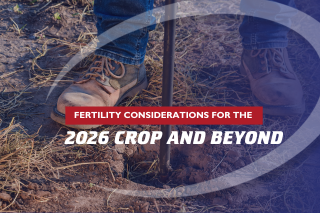Fertility Considerations for the 2026 Crop and Beyond
Oct 20, 2025

By Skott Gent and Dalton Roling
IAS Agronomy Advisors, Adrew Iowa
There has been a lot of talk in recent months about the cost of fertilizers — especially phosphates — and the possibility of reducing application rates this fall. While it may be tempting to cut back to save money, cutting corners on soil fertility is not the answer.
Rule No. 1: You can’t manage what you don’t measure.
If you haven’t grid-sampled all your fields in the past four years, get it scheduled. In my nearly 30 years in agronomy, I’ve never seen a field with uniform phosphorus (P) and potassium (K) levels across the board. The only way to know where you can reduce fertilizer rates without risking yield loss is through soil sampling.
Phosphorus and potassium play critical roles in plant growth. They support root development, aid in nutrient uptake and efficiency, and improve stress tolerance. This past season was a perfect example. Many of us experienced the wettest growing season ever. With nitrogen application rates being equal, fields with better overall fertility showed fewer symptoms of nitrogen loss than fields with low levels of P and K. Similarly, with the extreme pressure from leaf diseases this summer, we saw major differences in how corn and soybean plants tolerated the stress based on field fertility levels.
What are your actual yields compared to the yield goals you’ve been using to build your fertilizer prescriptions? Last year’s corn yields were far above expectations, and in many places, this year’s will be too. If you’re using 200 or 225 bushels per acre as your yield goal but producing 225 or 250 bushels (or more), you’re already losing ground. We can’t keep mining fertility from our soil and expect to maintain production and plant health long term. It’s much easier to stay proactive on soil fertility than to try to catch up “when fertilizer is cheaper.”
Do you no-till? Some growers want to wait until spring to apply fertilizer, hoping prices will better align with crop prices. But P and K are slow to move through the soil. The longer they have to work their way into the root zone, the greater the chance next year’s crop will benefit from this year’s application.
Sit down with your IAS agronomy advisor and take a big-picture look at your entire fertility strategy before making a knee-jerk reaction to the per-ton price of fertilizer. Look for ways to improve your return on investment rather than simply trying to lower costs.
A speaker at a conference I attended years ago said, “You can’t save yourself rich.” I’ve also heard it as, “You can never save your way to prosperity.” In crop production, it takes bushels to pay the bills. We need to produce those bushels as efficiently as possible — and our job is to help you do that.